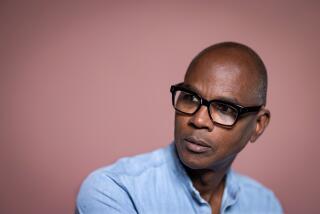Tom Kennedy dies at 48; sculptor created outlandish Art Cars
- Share via
Tom Kennedy, a San Francisco artist whose whimsical wheeled sculptures and colorful personality helped popularize the fringe Art Car movement, has died. He was 48.
Kennedy drowned April 12 while body-surfing off San Francisco’s Ocean Beach, said Kat “P.K.” Ramos, a close friend and roommate. He was struggling with the riptide when a companion tried to pull him to shore.
The dozens of vehicles that Kennedy transformed into outlandish, original art were joyful creative expressions, his way of winking at the world and daring people not to smile.
His “One-Eyed Wonder” started out as a Ford Ranger and featured a giant eyeball turret with a cannon that shot Twinkies. For a clown, he made two “Hippopautomobiles,” converting the front hoods into the animal’s broad, grinning mouth. A 1972 Volkswagen-turned-dolphin displayed a signature Kennedy touch, fins.
His first and perhaps most famous creation was “Ripper the Friendly Shark,” which he gave a saw-toothed jaw and a tail that swished. The once-simple Nissan Sentra eventually achieved something akin to landmark status in Houston, an early epicenter of the Art Car movement that started to coalesce in the 1990s.
The movement may have gotten a psychedelic assist from the hippie-themed VWs of the 1960s. But it is largely defined by an anything-goes mentality that likely appealed to Kennedy, widely described by friends as a merry prankster.
He was pursuing a career in circulation sales at the Houston Chronicle when he sought to enter the city’s annual Art Car parade in the early 1990s.
Kennedy “brought in this picture of this car that he had spray-painted and stuck these metal cutout shapes on and asked, ‘Can my car be in the parade?’ ” recalled Susanne Theis, a former director of the company that produces the parade.
“It was a primitive Art Car, but it morphed into a car that was iconic, and he turned himself into an artist,” she said. “He had this instinctive understanding that you needed to connect with people, and he worked at it.”
“Ripper” emerged as one of the Art Car movement’s “most recognized and inspiring” icons partly because Kennedy took the car “everywhere,” including to five Burning Man festivals of artistic self-expression in the Nevada desert, according to “Art Cars,” a 2007 book by Harrod Blank.
Kennedy’s cars stood out for their sculptural quality and for the way he used them to make political statements, said Philo Northrup, cofounder of ArtCar Fest, an annual Bay Area gathering.
When Ben Cohen of Ben & Jerry’s ice cream wanted to protest military spending, he hired Kennedy, whose team built the satirical “Topsy-Turvy” a school bus that had a second upside-down bus welded to its top. Completed in 2007, it was a visual pun that alluded to the idea that military spending came at the expense of education and health.
For the most part, Kennedy’s wheeled visions veered more toward buggies that were a “powerful bundle of whimsy,” he once said, capable of “reclaiming the commercialism of our culture.”
Kennedy was born Oct. 8, 1960, in Elizabeth, N.J., and had a nomadic childhood before settling in southern Oregon when he was about 12.
He studied business administration at Michigan Technological University from 1978 to 1981 then started out on the loading dock at the Houston Chronicle and rose to become circulation sales manager.
In 1992, he earned a bachelor’s degree in marketing from the University of Houston and spent the next two years studying sculpture at the school.
After leaving newspapers in 1995, he moved to the Bay Area to build Art Cars and concept vehicles and evolved “into the realm of being an Art Car character,” Kennedy once said.
There wasn’t much money in it, but between jobs he made functional art, such as gates and globes out of metals. And he reveled in the “growing tribe” of Art Car artists he saw as “goodwill ambassadors.”
Through a program he founded in 1996, he shipped bicycles to children in Bosnia during the war there and led an Art Car-inspired bicycle parade.
He ardently entered parades in the U.S. Over four years, he put 80,000 miles on “Max the Daredevil Finmobile,” a tow vehicle with 13-foot-high fins that could touch the trees.
In 2007, he married Haideen Anderson, a political performance artist who collaborated on his projects.
The artist defined himself as an “adventurer” and once said: “It seems the world is a little short of adventurers right now. Too many people sitting behind a TV or like a computer screen. Someone’s got to be out on the street creating the content. That’s me.”
In addition to his wife, Kennedy’s survivors include his mother, Pat; sister Margret; and brothers Matt and Andy.
Plans for the May 1 memorial include an Art Car convoy that starts in San Francisco and ends with a celebration in Oakland. For details, or to make a memorial donation, go to tomkennedyart.com Donations may be earmarked to the Nonviolent Peaceforce,to a fund to retrieve “Ripper” from storage in Europe, or to defray the cost of the memorial service.
More to Read
Start your day right
Sign up for Essential California for the L.A. Times biggest news, features and recommendations in your inbox six days a week.
You may occasionally receive promotional content from the Los Angeles Times.








